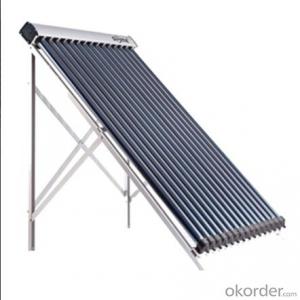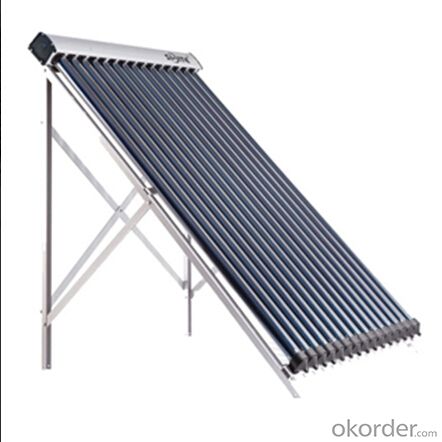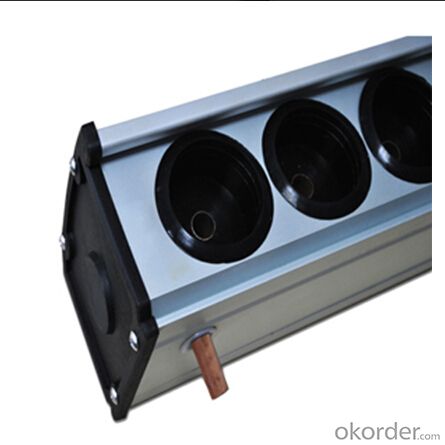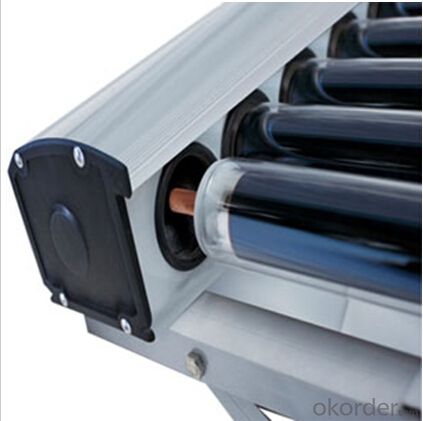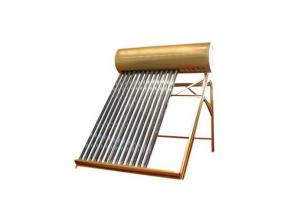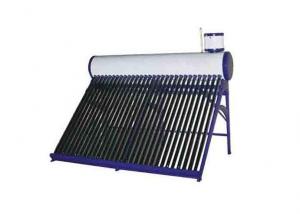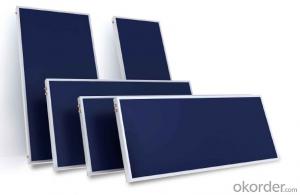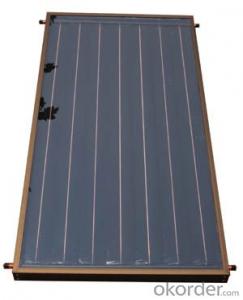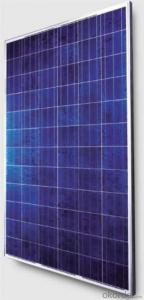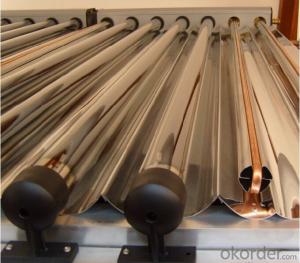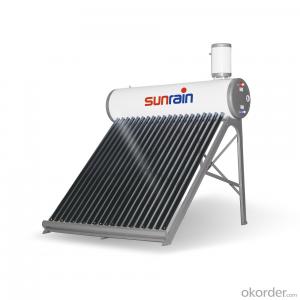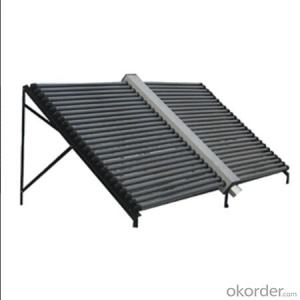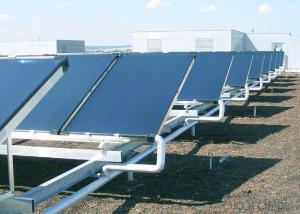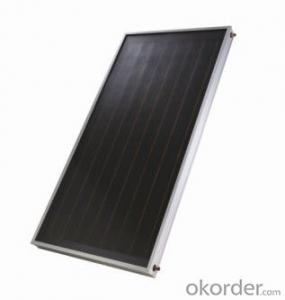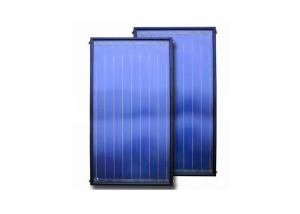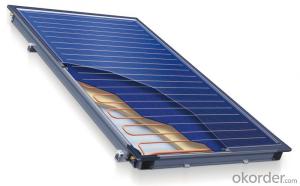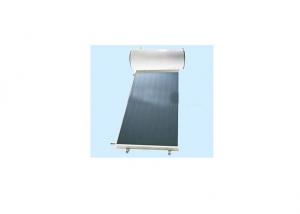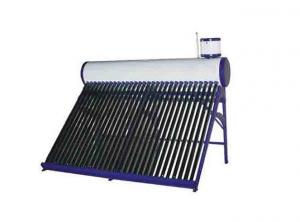Non Concentrating Solar Collectors - Inlet and Outlet at the Bottom of Manifold SC-HD
- Loading Port:
- Shanghai
- Payment Terms:
- TT OR LC
- Min Order Qty:
- 1 set
- Supply Capability:
- 2500 set/month
OKorder Service Pledge
OKorder Financial Service
You Might Also Like
1. Structure of Inlet and Outlet at the bottom of Manifold Solar Collector Model SC-HD Description:
This product is composed of Aluminium alloy for frame, rock wool for the insulation,tri-element vacuum glass tube and antifreeze heat pipe.It can often be used in subzero temperatures without the system sustaining damage. Flat plate systems often require expensive and complicated "antifreeze" systems to be installed.
2. Main Features of Inlet and Outlet at the bottom of Manifold Solar Collector Model SC-HD
1) The inlet and outlet be opened on the bottom of manifold; It looks more artistic than trandithional manifold;
2) Good sealed in end of cover, It can provide higher insulation efficiency;
3) The most advantage is that It can be Emptyed the medium( water or deicing fluid) in the Manifold;
3. Inlet and Outlet at the bottom of Manifold Solar Collector Model SC-HD Images
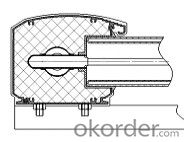
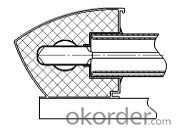
4. Inlet and Outlet at the bottom of Manifold Solar Collector Model SC-HD Specifications
Model | SC-HD-10 | SC-HD-15 | SC-HD-18 | SC-HD-20 | SC-HD-24 | SC-HD-25 | SC-HD-30 |
SC-H1-10 | SC-H1-15 | SC-H1-18 | SC-H1-20 | SC-H1-24 | SC-H1-25 | SC-H1-30 | |
Vacuum tube quantity(pcs) | 10 | 15 | 18 | 20 | 24 | 25 | 30 |
Tube spacing (㎜) | 75 | 75 | 75 | 75 | 75 | 75 | 75 |
Vacuum tube diameter/length (㎜) | φ58/1700 | φ58/1700 | φ58/1700 | φ58/1700 | φ58/1700 | φ58/1700 | φ58/1700 |
Vacuum tube material | high borosilicate glass 3.3 | high borosilicate glass 3.3 | high borosilicate glass 3.3 | high borosilicate glass 3.3 | high borosilicate glass 3.3 | high borosilicate glass 3.3 | high borosilicate glass 3.3 |
Vacuum tube inner/outer pipe wall thickness (㎜) | 1.6/1.8 | 1.6/1.8 | 1.6/1.8 | 1.6/1.8 | 1.6/1.8 | 1.6/1.8 | 1.6/1.8 |
Heat pipe condensing end diameter/length (㎜) | φ14/1750 | φ14/1750 | φ14/1750 | φ14/1750 | φ14/1750 | φ14/1750 | φ14/1750 |
heat pipe material/wall thickness (㎜) | Copper tp2/0.6 | Copper tp2/0.6 | Copper tp2/0.6 | Copper tp2/0.6 | Copper tp2/0.6 | Copper tp2/0.6 | Copper tp2/0.6 |
inner tank diameter/wall thickness (㎜) | φ35/1.0 | φ35/1.0 | φ35/1.0 | φ35/1.0 | φ35/1.0 | φ35/1.0 | φ35/1.0 |
connector size | φ22 or 3/4″ | φ22or 3/4″ | φ22or 3/4″ | φ22or 3/4″ | φ22or 3/4″ | φ22or 3/4″ | φ22or 3/4″ |
collector insulation material/thickness (㎜) | Rock wool/40 | Rock wool/40 | Rock wool/40 | Rock wool/40 | Rock wool/40 | Rock wool/40 | Rock wool/40 |
solar collector rated pressure (MPa) | 0.6 | 0.6 | 0.6 | 0.6 | 0.6 | 0.6 | 0.6 |
collector operating temperature ℃ | <100 | <100 | <100 | <100 | <100 | <100 | <100 |
collector volume (L) | 0.69 | 0.98 | 1.15 | 1.27 | 1.50 | 1.56 | 1.85 |
collector aperture area (㎡) | 1.0 | 1.5 | 1.8 | 2.0 | 2.4 | 2.5 | 3.0 |
collector total area (㎡) | 1.56 | 2.30 | 2.74 | 3.04 | 3.63 | 3.77 | 4.51 |
referral traffic (L/min) | 0.75 | 1.13 | 1.35 | 1.50 | 1.81 | 1.88 | 2.26 |
intensity pressure (Pa) | 23.2 | 59.2 | 90.6 | 116.7 | 181.7 | 200.2 | 314.0 |
intercept efficient η0 | 0.744 | 0.744 | 0.744 | 0.744 | 0.744 | 0.744 | 0.744 |
heat loss coefficient a | 2.09 | 2.09 | 2.09 | 2.09 | 2.09 | 2.09 | 2.09 |
collector power (W)1000W/㎡ irradiation | 620 | 870 | 1047 | 1165 | 1401 | 1457 | 1748 |
collector net weight (kg) | 38.25 | 50.75 | 59.75 | 64.75 | 79.00 | 83.35 | 98.70 |
a (㎜) | 895 | 1270 | 1495 | 1645 | 1945 | 2020 | 1395 |
b (㎜) | 800 | 1175 | 1400 | 1550 | 1850 | 1925 | 2300 |
c (㎜) | 725 | 1100 | 1325 | 1475 | 1775 | 1850 | 2225 |
c/2 (㎜) | —— | —— | —— | —— | 887.5 | 925 | 1112.5 |
d (㎜) | 1980 | 1980 | 1980 | 1980 | 1980 | 1980 | 1980 |
e (㎜) | 1240 | 1240 | 1240 | 1240 | 1240 | 1240 | 1240 |
f (㎜) | 1470 | 1470 | 1470 | 1470 | 1470 | 1470 | 1470 |
5. FAQ
(1) Which collector is the best value for money?
Rather than looking at just peak efficiency levels when comparing solar collectors, cost per unit of energy produced is much more logical. For example: Although collector A may be 20% more efficient than collector B, if collector A is 30% more expensive, then in fact collector B may be a better choice, as per kWh of energy produced per day it is cheaper. When payback time is of concern, not only price per kWh of the product is important, but also of the end system.
(2) Can this solar collectors be used for a large scale hot water production?
Yes. This solar collectors can be connected in series or parallel to provide large scale hot water production for a commercial settings such as a school, hotel or office building. There is really no limit to the size of the system, however collectors must be installed in banks of no more than 150 tubes (in series), otherwise the water may boil.
(3) What maintenance of the solar collector is required?
Under normal circumstances no maintenance of the system is required. Due to the shape of the tubes regular rainfall and wind should keep the tubes clean. Should a tube even be broken it should be replaced. This, however, is an inexpensive and easy job. Any "handy" person can install a new tube (while adhering to local health and safety regulations). Sidite solar collectors can operate with several broken tubes, however the efficiency will be reduced slightly.
- Q: Can solar collectors be used for space cooling?
- Yes, solar collectors can be used for space cooling. Solar cooling systems utilize the heat from the sun to power absorption or adsorption chillers, which in turn provide cooling for buildings or spaces. These systems work by converting solar energy into thermal energy to generate the cooling effect, making them an environmentally-friendly and sustainable solution for space cooling.
- Q: Can solar collectors be used for heating parking lots?
- Yes, solar collectors can be used for heating parking lots.
- Q: Can solar collectors be used in urban areas?
- Yes, solar collectors can be used in urban areas. While space constraints and shading from tall buildings may limit their efficiency, solar collectors can still be installed on rooftops, facades, or in open spaces such as parks and parking lots. Additionally, advancements in technology have led to the development of more compact and efficient solar panels, making them increasingly viable for urban settings.
- Q: How much space is needed to install a solar collector?
- The space needed to install a solar collector can vary depending on the size and type of collector being used. Typically, a residential solar collector for heating water or generating electricity would require an area of around 100-250 square feet. Commercial or larger-scale solar collectors may require much larger spaces, sometimes spanning several acres.
- Q: Can solar collectors be used in wave energy converters?
- Solar collectors cannot be utilized directly in wave energy converters. The purpose of solar collectors is to seize sunlight and transform it into thermal or electrical energy. Conversely, wave energy converters are exclusively engineered to exploit the kinetic energy of ocean waves. The mechanisms and technologies employed in these two energy conversion systems differ significantly, rendering them incompatible with one another. Solar collectors are better suited for solar power generation, whereas wave energy converters are specifically designed for wave power generation, capitalizing on the uninterrupted motion of the ocean to generate electricity.
- Q: Can solar collectors be used for drying crops?
- Yes, solar collectors can be used for drying crops. Solar collectors, such as solar dryers, can harness the sun's energy to provide heat for drying agricultural products. This method of crop drying can be more cost-effective and environmentally friendly compared to traditional drying methods.
- Q: Can solar collectors be used for generating electricity on drones?
- Yes, solar collectors can be used for generating electricity on drones. By installing solar panels on the surface of the drone, the sunlight can be converted into electrical energy, which can power the drone's systems and even extend its flight time. This technology is already being explored and implemented in various drone designs, enabling longer endurance and more sustainable operations.
- Q: Can solar collectors be used for agricultural purposes?
- Yes, solar collectors can be used for agricultural purposes. Solar collectors can provide renewable energy to power various agricultural operations such as irrigation systems, livestock watering, greenhouse heating, and crop drying. They can help reduce dependence on fossil fuels, lower energy costs, and contribute to a sustainable and eco-friendly farming approach.
- Q: Can solar collectors be used for generating electricity on rooftops in cities?
- Indeed, solar collectors can be utilized in urban areas to produce electricity on rooftops. Also known as solar panels or photovoltaic (PV) panels, solar collectors have the capability to convert sunlight into electrical energy. They can be conveniently mounted on the rooftops of city buildings to harness the copious solar energy available in these locations. Solar panels consist of numerous photovoltaic cells constructed from materials like silicon. When sunlight strikes these cells, it stimulates the electrons within them, resulting in the generation of an electric current. This electricity can then be employed to power a variety of appliances and devices within the building. There are several advantages to installing solar panels on rooftops in cities. Firstly, rooftops provide a spacious area that is often unobstructed by shade or other buildings, ensuring ideal exposure to sunlight. Moreover, the installation of solar panels on rooftops optimizes the utilization of limited space in densely populated urban areas. The generation of electricity through solar collectors on rooftops is an environmentally friendly and renewable energy solution. It diminishes dependence on fossil fuels and reduces greenhouse gas emissions, thus contributing to the battle against climate change. Additionally, rooftop solar installations can enhance the energy independence and resilience of cities, as they generate electricity directly where it is needed. Furthermore, solar collectors on rooftops can yield economic benefits as well. By generating electricity on-site, building owners can reduce their reliance on the power grid and lower their energy expenses. In certain cases, surplus electricity generated can be fed back into the grid, enabling building owners to earn credits or revenue through mechanisms such as net metering or feed-in tariffs. Nevertheless, there are certain factors to consider when installing solar collectors on rooftops in cities. Building codes, structural requirements, and shading issues must be taken into account to ensure the secure and efficient installation of solar panels. Additionally, the initial cost of purchasing and installing solar panels may pose a barrier for some building owners, although the long-term financial advantages usually outweigh the upfront investment. In conclusion, solar collectors can definitely be employed to generate electricity on rooftops in cities. They offer a clean, renewable, and economically viable solution to fulfill the energy needs of urban areas while minimizing environmental impact. With proper planning and installation, rooftop solar installations can serve as valuable assets in the transition towards a more sustainable and energy-efficient future.
- Q: Can solar collectors be used in residential heating systems?
- Residential heating systems can utilize solar collectors to harness the power of the sun. These solar thermal panels are specifically designed to capture the sun's energy and convert it into heat. By doing so, they can supply hot water and heating to residential buildings. Two main types of solar collectors are commonly used in residential heating systems: flat plate collectors and evacuated tube collectors. Flat plate collectors consist of an absorber plate, covered with a transparent layer and insulated to prevent heat loss. On the other hand, evacuated tube collectors consist of glass tubes with a vacuum inside, which enhances their efficiency in capturing solar energy. Integrating solar collectors into residential heating systems can fulfill a significant portion of the heating requirements. They can directly heat water, which can then be used for various household activities like showers and dishwashing. Alternatively, the collected heat can be circulated through the collectors and transferred to a heat exchanger in the building to provide space heating. The usage of solar collectors in residential heating systems brings numerous benefits. Primarily, it reduces reliance on traditional energy sources like fossil fuels, resulting in lower greenhouse gas emissions and a reduced environmental impact. Furthermore, it can yield substantial cost savings as solar energy is free and abundant. Lastly, solar collectors have a long lifespan and require minimal maintenance, making them a dependable and durable option for residential heating. However, it's important to acknowledge that the effectiveness of solar collectors in residential heating systems depends on various factors, such as climate, collector orientation and tilt, and system size. In areas with limited sun exposure or low solar radiation, the efficiency of solar collectors may be diminished. Additionally, the initial installation cost of solar collectors can be higher compared to conventional heating systems, but the long-term savings can outweigh this investment. In conclusion, solar collectors can be effectively utilized in residential heating systems to provide hot water and space heating. They offer a sustainable, cost-effective, and dependable solution for reducing energy consumption and minimizing environmental impact in residential buildings.
Send your message to us
Non Concentrating Solar Collectors - Inlet and Outlet at the Bottom of Manifold SC-HD
- Loading Port:
- Shanghai
- Payment Terms:
- TT OR LC
- Min Order Qty:
- 1 set
- Supply Capability:
- 2500 set/month
OKorder Service Pledge
OKorder Financial Service
Similar products
Hot products
Hot Searches
Related keywords
